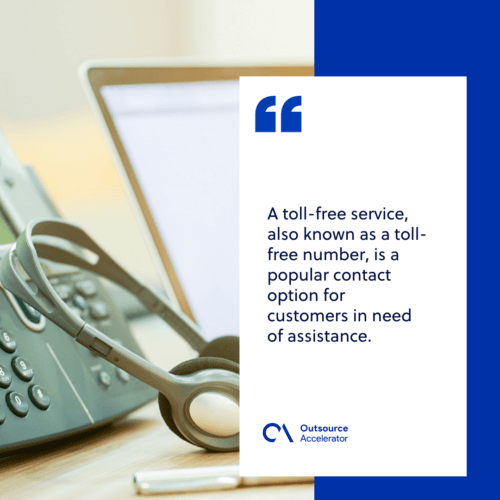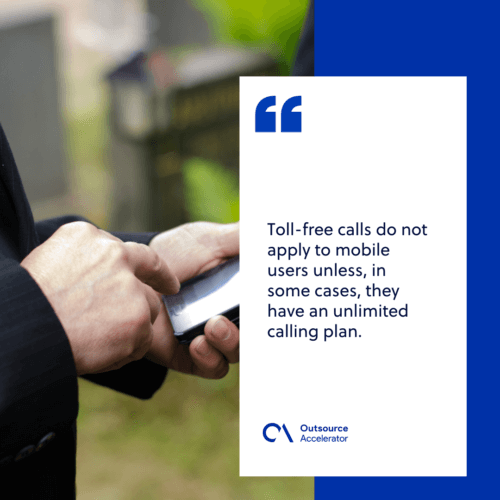Toll-free service
Definition
What is a toll-free service?
A toll-free service, also known as a toll-free number, is a popular contact option for customers in need of assistance.
Instead of the caller getting billed, the toll-free number gets charged for every call received. In other words, it is the company that assumes the call charges so that customers and prospects can contact them freely.

Toll-free number codes
You can easily recognize a toll-free service number through its first three digits.
Common toll-free number prefixes include 800, 833, 844, 855, 866, 877, and 888, among others.
These toll-free numbers are not interchangeable. That means if you dial a 1-800 number, you will get a different person from a 1-888 number. Local telephone numbers are assigned to each toll-free number.
Vanity number
Vanity numbers are an example of toll-free service, although they can also be paid numbers.
Vanity numbers are shared-use numbers that typically spell out a business name or a word related to it — e.g., 1-800-GoFedEx or 1-800-4633339 when dialed on a phone keypad.
These numbers are meant to be easily memorized and associated with a certain brand. A one-of-a-kind phone number is sought after as a branding and direct-response tool. Choosing the right vanity number can significantly impact a business’s success.
Advantages of toll-free service
Setting up a toll-free number for your business offers the following advantages.
- Consumers can reach you more easily, so you don’t miss out on opportunities to generate and nurture leads.
- A toll-free line is available round-the-clock so that you can respond to consumers’ inquiries from any location.
- Toll-free numbers are usually easy to remember and recall, especially if they’re vanity numbers.
- Customers have traditionally been able to get in touch with businesses through toll-free numbers.
- As long as toll-free numbers are text-enabled, customers can send text messages to businesses and vice versa.
- Toll-free phone systems are generally set up to allow call forwarding to any other number, such as an IP phone or landline.
Disadvantages of toll-free service
Here are the possible drawbacks of toll-free services for your business:
- Toll-free calls do not apply to mobile users unless, in some cases, they have an unlimited calling plan.
- From the business perspective, the more time you spend on calls, the more expensive they get. Because of this, several service providers offer plans that lower their cost-per-minute based on the number of calls you intend to make each month.
- “Hoarding” is prohibited by FCC regulations. There is a limit to the number of toll-free numbers purchased by a subscriber.

Toll-free number providers
Cloud telephony service providers and telecom firms like Airtel, Vodafone, The Real PBX, and CallHippo offer toll-free numbers for their customers.
Airtel
Airtel (Bharti Airtel Limited) is an Indian telecommunication service provider with headquarters in New Delhi, India. It offers both domestic and international toll-free services, with features such as smart call forwarding and call statistics.
Vi (Vodafone Idea)
With operations across the globe, the Vodafone Group is a British telecommunication giant whose India-based spinoff Vi offers various toll-free services for businesses. Choose from domestic or international toll-free service, universal access number, or universal international freephone number.
The Real PBX
To receive calls on your cell phone or Skype, you need to sign up for a toll-free number with the Real PBX. It is a hosted business phone system that has all the functionality of a typical VoIP phone, as well as unique advantages.
CallHippo
CallHippo offers a wide range of virtual mobile phone numbers tailored to the demands of small businesses. Small businesses can use the CallHippo platform to set up a virtual call center and expand their reach to local and international clients, as it operates in more than 50 countries.
It has a simple and intuitive UI. Setting up a customer service center for any business group takes less than three minutes.







 Independent
Independent




